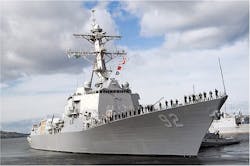Navy destroyers to increase efficiency and save fuel with new hybrid electric propulsion
WASHINGTON, 6 July 2015. U.S. Navy shipboard propulsion experts are taking the next step in enhancing the fuel-saving efficiency of propulsion systems aboard late-model Arleigh Burke-class destroyers by developing a hybrid electric drive propulsion for these surface warships.
Officials of the Naval Sea Systems Command in Washington announced a $7.6 million contract modification last week to L-3 Communications Maritime Systems segment in Leesburg, Va., to build the first two shipsets of the Hybrid Electric Drive (HED) Electric Propulsion System (EPS) for Burke-class destroyers.
Engineers at L-3 Maritime Systems will build an integrated HED EPS suitable for backfit aboard Burke-class destroyer Flight IIA ships. The HED EPS will provide an additional propulsion option at low speeds to burn less fuel than is possible with the existing installed equipment, Navy officials say.
The HED EPS is designed to solve the Navy's problem of relatively high fuel consumption at low speeds, where surface warships typically operate. The system attaches an electric motor to the propulsion plant to enable the ship to draw power from the ship’s electric generators and shut down main propulsion engines.
Using the ship’s electrical power for propulsion at slow speeds can save much fuel. The HED EPS just half the time can increase time on station by as much as two-and-a-half days between refuelings.
On this order L-3 Maritime Systems will do the work in Mankato, Minn; Zamudio, Spain; and Leesburg, Va., and should be finished by July 2016.
For more information contact L-3 Maritime Systems online at www.l-3mps.com/maritimesystems, or Naval Sea Systems Command at www.navsea.navy.mil.

